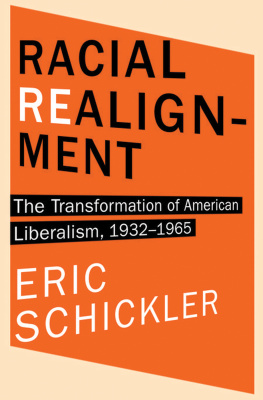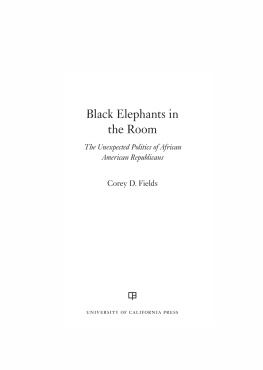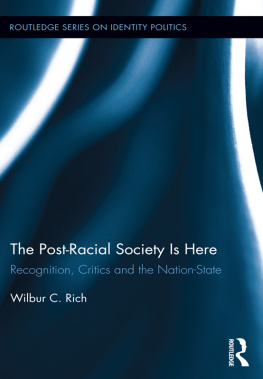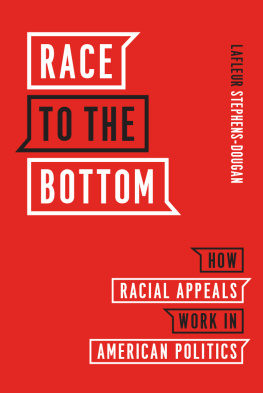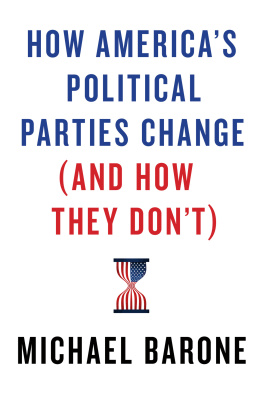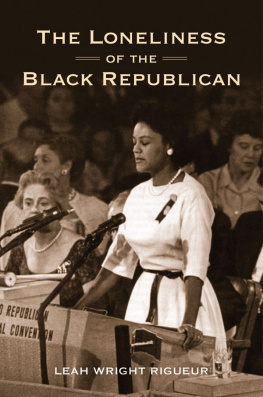
RACIAL REALIGNMENT
PRINCETON STUDIES IN AMERICAN POLITICS: HISTORICAL, INTERNATIONAL, AND COMPARATIVE PERSPECTIVES
IRA KATZNELSON, ERIC SCHICKLER, MARTIN SHEFTER, AND THEDA SKOCPOL, SERIES EDITORS
A list of titles in this series appears at the back of the book
RACIAL REALIGNMENT
THE TRANSFORMATION OF AMERICAN LIBERALISM, 19321965
Eric Schickler
PRINCETON UNIVERSITY PRESS
PRINCETON AND OXFORD
Copyright 2016 by Princeton University Press
Published by Princeton University Press, 41 William Street, Princeton, New Jersey 08540
In the United Kingdom: Princeton University Press, 6 Oxford Street, Woodstock, Oxfordshire OX20 1TW
press.princeton.edu
All Rights Reserved
ISBN 978-0-691-15387-2
ISBN (pbk.) 978-0-691-15388-9
British Library Cataloging-in-Publication Data is available
This book has been composed in Sabon
Printed on acid-free paper.
Printed in the United States of America
1 3 5 7 9 10 8 6 4 2
Contents
PART 1
TRANSFORMING AMERICAN LIBERALISM |
PART 2
REALIGNMENT FROM BELOW: VOTERS AND MIDLEVEL PARTY ACTORS |
PART 3
THE NATIONAL PARTIES RESPOND |
Illustrations
FIGURES
TABLE
Acknowledgments
THIS BOOK WOULD not have come together without the help of many colleagues, both at Berkeley and across the country.
The project depended on several major, collaborative data collection efforts. Brian Feinstein, who started out as a research assistant but soon became a coauthor, played a pivotal role in putting together the collection of state party platforms that launched the project (see Feinstein and Schickler, Platforms and Partners: The Civil Rights Realignment Reconsidered, Studies in American Political Development, 2008). This database serves as one of the foundations for .
Special thanks are due to Ira Katznelson, who was the first to suggest that the initial research on the civil rights realignment at the state and congressional levels could serve as the basis for a book that might make a broader contribution to the study of political change. Throughout the process, Katznelson was a source of insight and advice, commenting on both individual papers and the manuscript as a whole. Robert Mickey, David Mayhew, Richard Valelly, and Anthony Chen each also deserve special acknowledgment for offering terrific comments both as I first launched the book project and several years later as I completed the manuscript.
As the project developed, I received useful comments and feedback from numerous colleagues, including Richard Bensel, David Karol, Frances Lee, Paul Pierson, Paul Sniderman, John Zaller, Kathleen Bawn, Christopher Baylor, Richard Beth, Dan Carpenter, Ted Carmines, Jack Citrin, Chris Deering, Erik Engstrom, Kathleen Frydl, Paul Frymer, Sean Gailmard, Alan Gerber, John Gerring, Don Green, John Griffin, Rodney Hero, Jeff Jenkins, Samuel Kernell, Thad Kousser, John Lapinski, Taeku Lee, Gabe Lenz, Robert Lieberman, Nolan McCarty, Suzanne Mettler, Sid Milkis, Hans Noel, Kevin Quinn, Jas Sekhon, Daniel Schlozman, Merrill Shanks, Robert Shapiro, John Sides, Theda Skocpol, Laura Stoker, Vanessa Tyson, Robert Van Houweling, Lynn Vavreck, Dorian Warren, Greg Wawro, and Vesla Weaver. I thank Thomas Ogorzalek, John Lapinski, Scott Adler, and John Wilkerson for generously sharing their congressional data.
Several current and former graduate students also played a critical role in the project. Devin Caughey made major contributions as a research assistant and as a collaborator on several related projects. Devins innovative method for estimating the dynamics of state- and group-level opinion provided a key resource for the analyses in . In addition to providing sterling research assistance, Ruth Bloch Rubin generously shared several critical finds from her dissertation research in the archives of southern members of Congress. Emily Hertz deserves special thanks for her superb work as a research assistant and as a commenter on each chapter of the manuscript; Hertzs contributions in helping me think through the structure of the argument and presentation in each chapter constituted the kind of wise feedback one expects from a senior colleague rather than a second-year Ph.D. student.
I also benefited from excellent research assistance from Sara Chatfield, Michael Dougal, Jake Grumbach, Peter Hanson, Erin Hartman, John Henderson, Adrienne Hosek, Tony Huynh, Morris Levy, Mark Oleszek, Eleanor Powell, Arman Rezaee, Adam Silver, Alex Theodoridis, Joseph Warren, Nicole Fox Wilcoxon, and Ian Yohai. Berkeley undergraduates Mariam Azhar, Sean Diament, Lena Ghamrawi, Deepa Kollipara, and Raquel Pelke also provided important research help.
I am grateful to Eric Crahan at Princeton University Press for his guidance and his encouragement of the project throughout the process. I also thank Chuck Myers, who was the editor at Princeton when I first framed the initial book prospectus for an advance contract.
Finally, my deepest gratitude goes to Terri Bimes, Sam Schickler, and Lea Schickler, for their unending love and support. It is to them that this book is dedicated (though I suspect Lea and Sam would not forgive me if I did not mention Wilburs name as well).
RACIAL REALIGNMENT
CHAPTER 1
Introduction
TODAY POLITICAL OBSERVERS take for granted the idea that Democratic partisanship, economic liberalism, and racial liberalism cohere under a common programmatic banner, just as Republican partisanship is associated with economic conservatism and greater resistance to government programs to redress problems of racial inequality. But the emergence of these linkages is a relatively recent phenomenon. Prior to the 1930s Republican elites provided greater (if often only tepid) support for civil rights than did their Democratic counterparts. By the mid-1960s, however, Democratic partisanship and economic liberalism were clearly identified with civil rights support and Republican conservatism had become identified with greater opposition to governmental action to redress racial inequalities. This book aims to explain the dynamics of this momentous transformation.
The partisan transformation on race is often depicted as an elite-led, center-driven shift that occurred in the 1960s, breaking apart the New Deal coalition that had dominated American politics for more than a generation. By contrast, I show that the realignment began with mass and midlevel party actors, that it was rooted in state and local politics rather than in Washington, DC, and that much of the important work was complete by the mid-1940s. In doing so, I aim to provide a new way of thinking about the nature of the New Deal coalition and of the political significance of New Deal liberalism more generally. This account also has important implications for theories of political parties and of political change in the United States. Thus the civil rights realignment is important both in its own right and as a window into the workings of the American political system more broadly.
THE CONVENTIONAL VIEW OF THE CIVIL RIGHTS REALIGNMENT
Although scholars have studied the civil rights realignment from a wide variety of angles, three related claims have shaped the prevailing understanding of its dynamics. The first claim is that national party elites played the
This reshuffling of party coalitions launched the postNew Deal party system in which Democrats were identified with African Americans and racial liberalism, while Republicans were associated with racial conservatism.
Second, national political actors take center stage in this story, in part because federalism is understood to be a key blockage preventing action on civil rights. Federalism gave southerners secure control of law enforcement and the means of coercion in their region while allowing southern elites to appeal to the rhetoric of states rights to justify their discriminatory policies. Federalism also meant that state party competition often focused on local issues, with the result that many northern state Democratic parties consisted of inward-looking political machines with little commitment to programmatic liberalism. Change had to come from the top down because only nationally oriented political actors had the capacity and (eventually) the will to move policy on racial issues. The civil rights movement figures into this story as an important source of pressure on these national political elites, but the crucial step was to persuade top party leaders based in Washington that they needed to act.
Next page
